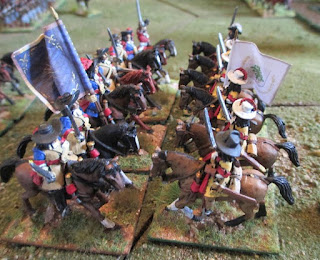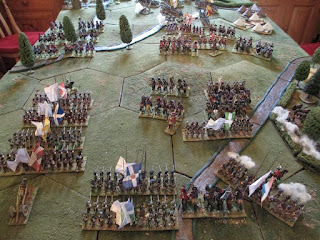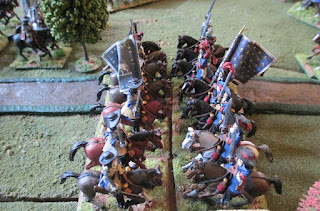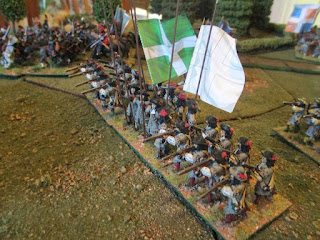Somewhere in the Rhineland, 1675, the Battle of Schwarz Ridge.
Taking advantage of the fact I could use the dining room for
a second day, I reused the hex scenery set out for my ACW game earlier in the
week to have Sun King game. I used a scenario from C.S. Grant’s book, Programmed Wargames Scenarios, the Flank Attack. I had to reverse the map to
allow for the fact my ridge ran the opposite way to that in his scenario, tweaked the scenery to make the table a bit more interesting, and
then adjusted the forces so that they were more suitable for a late 17th
Century engagement. I then played the scenario as if both sides were programmed.
The French were the attackers, the Allies on the defence. By
the close of play, after fifteen turns (the table was needed for Sunday
dinner!), the French had gained possession of the west end of the ridge and
were threatening to seize the Allied camp, but their supporting frontal attack,
which had pinned the Allies in position, was suffering heavy casualties. I have
added a map of the battle at the end of the photographs, along with the forces
of the two sides.
The battlefield with the Allied army deployed to meet an expected frontal assault.
The Allied right wing cavalry - Dutch and Hesse Kassel units.
The Allied centre - Dutch, Münster, Imperial and Brandenburg units, along with their artillery support.
The Allied left wing horse - Dutch and Spanish units, with Imperial Croats at the rear.
The Allied dragoons - the Dutch Marwitx Regiment.
The French cavalry enter the table - three regiments at the head of each column.
The French cavalry engages the Allied horse as the French foot units begin to arrive on the field.
French foot - Grancey at the front, Douglas behind.
Champagne followed by Condé.
At the bottom right, Condé Foot Regiment wheels to engage the Dutch dragoons.
Normandie and Royal Italien enter the battlefield behind Douglas.
La Couronne and Guiche arrive on the battlefield.
Royal Cravattes and Alcantara in action.
The Dutch Reede Foot Regiment.
Squadrons of Royal Cravattes and Colonel-Général fighting Waldeck and Alcatara. Under the rules, an existing combat can be reinforced from the rear of flank by a supporting squadron.
The Cuirassiers du Roi charging the Allied medium gin battery. The attack was a success, the battery being overrun, but the French squadron was severely weakened by hailshot.
Hoornbergh and Roi in action on the Allied right wing.
Condé and Marwitz fight it out in the wood.
Allied foot units hastily realigning to meet the flank attack.
Baden-Durlach firing on the Cuirassiers du Roi.
The Brandenburg unit, Grafen von Dohna, with a grenadier company on its right flank.
Alcantara breaks in rout,
The two sides exchanging musketry amongst the trees.
In the end, Condé prevailed and the dragoons fled the field.
The Croats about to engage Dauphin, not a wise idea for the hussars, as they were routed easily by the more disciplined French horsemen.
Reede fending off French cavalry with steady volleys.
Cuirassiers du Roi attacked Baden-Durlach, but were beaten off by the infantry.
The French medium gun battery in draught. The French artillery did not get into action at all during the game, unable to get into the line of battle.
The Dutch Ingen-Nielant Foot Regiment.
Plenty of Allied horse squadrons holding the French left column's cavalry at bay.
Reede were charged by French cavalry, but beat them off easily.
The French left column's infantry units deploying for their frontal assault to pin the Allied line.
The French right column's infantry units moving along the ridge.
Erbach and Commissaire-Général fighting near the farm.
Reede and Champagne exchanging volleys.
The French frontal attack goes in. Normandie shooting at the Allied light gun battery, which lashed them with hail shot in return.
Reede on the left succumbed to a French cavalry charge into its flank, the unit surrendering rather than be put to the sword, whereas Münster on the right beat off a frontal charge.
Plenty of musketry all along the opposing lines.
Grancey charged Grafen von Dohna and was beaten off.
Normandie advanced on the Allied light gun battery, but suffered such losses that its attack stalled.
Grancey attacked again, but was taken in the flank by Hoornbergh and destroyed in the ensuing combat.
The battlefield at the close of play (the table was required for Sunday dinner!). The French pushing along the ridge and towards the |Allied camp, but stalled in front, although their cavalry was making progress near the farm.
Opposing Forces:
French:
Right Wing
Column:
One
C-in-C General
Two
Brigade Generals
Four
Foot Regiments
Three
Cavalry Regiments (each two squadrons)
One
Medium Gun Battery
Left Wing Column:
Two
Brigade Generals
Four
Foot Regiments
Three
Cavalry Regiments (each two squadrons)
One Light Gun Battery
Allied:
Left Wing:
One
Brigade General
Two
Cavalry Regiments (each two squadrons)
One
Hussar Regiment
Centre:
One
C-in-C General
One
Brigade General
Six
Foot Regiments
One
Medium Gun Battery
One
Light Gun Battery
Right Wing:
One
Brigade General
Three
Cavalry Regiments (each two squadrons)
























































































Another great looking battle!
ReplyDeleteThanks for all the pictures and eye candy, really enjoyed your table, I really must get my Programmed Wargames Scenario book out and do something with it.
ReplyDeleteGoodness, those are some impressive armies! Love that era too. If you said what rules you were using, I missed it.
ReplyDeleteThanks for the nice comments! The rules are based on a Renaissance set by Adrian Hussey that appeared in Battlegames many years ago. They were originally a hex-based system, but I converted them to feet and inches and adapted them for the Sun King period.
ReplyDelete